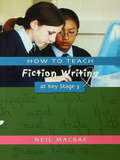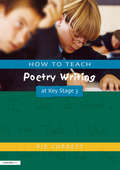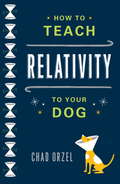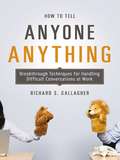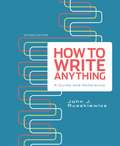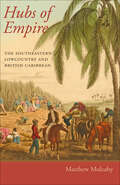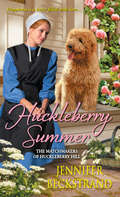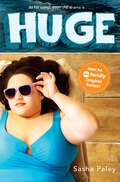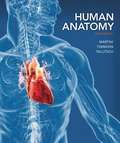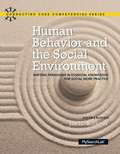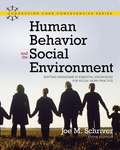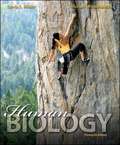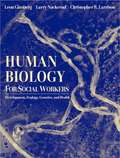- Table View
- List View
How to Teach Fiction Writing at Key Stage 3
by C Neil MacraeHow to Teach Fiction Writing at Key Stage 3 is a practical manual to help teachers of 11-14 year-olds to develop effective modeling and scaffolding strategies for the teaching of narrative writing. Using a step-by-step approach, based on the 'word/sentence/text level' convention, the book shows how teachers can help pupils to build work in various genres and to move out from these to more complex writing. Each section has a workshop approach that leads into a narrative writing activity, giving pupils the chance to complete a fully realized piece of work at the end each time. The workshops focus on genre features, the craft of the writer, and specific year-related needs (taken from the KS3 Framework). The book has a clear progression through KS3, and extension and support activities for the most and least able pupils are provided as an integral part of each section.
How to Teach Poetry Writing at Key Stage 3
by Pie CorbettHow to Teach Poetry Writing at Key Stage 3 is a practical manual for teachers, to be used directly in the classroom. The book begins with a series of poetry games designed to warm up creativity and strengthen the imagination. These are followed by a series of creative poetry workshops, based on the writer's own experience both as a teacher and poet running workshops in schools, which focus on developing a 'poetry base' for young writers. This imaginative base provides a range of poetic techniques and gives pupils experience in developing a repertoire of different forms. The book also offers advice on how to organize an effective workshop, and demonstrates how to teach poetry writing in a dynamic, creative and imaginative way in relationship with the KS3 national framework. Pie Corbett also provides useful advice on working with visiting poets in school, addresses for relevant web-sites, a list of books for follow-up work and a glossary of poetic forms and techniques. Workshops include writing from first hand observation; autobiography - valuing our lives; writing about paintings, sculpture and music; surreal boxes and the bag of words; secrets, lies, wishes and dreams; creating images, taking word snapshots; riddles - hiding the truth; and red wheelbarrows and messages for mice.
How to Teach Relativity to Your Dog
by Chad OrzelIn this accessible introduction to general and special relativity for students and general readers, Orzel (physics, Union College) explains concepts such as the Big Bang to Nero, a cat who believes he is the center of the universe, and Emmy, the dog who mastered quantum physics in Orzel's previous book. The book alternates between humorous human-pet dialogues and plain language explanations using everyday examples. It includes b&w illustrations explaining concepts, plus an extensive glossary and a brief bibliographic essay. Annotation ©2012 Book News, Inc. , Portland, OR (booknews. com)
How to Tell Anyone Anything: Breakthrough Techniques for Handling Difficult Conversations at Work
by Richard GallagherNo one likes to be criticized, but this book teaches the communication skills needed to successfully get the message across while keeping feelings and relationships intact.Drawing from the latest in psychology on how best to connect with others, How to Tell Anyone Anything steers you away from the common mistake of providing feedback by focusing on what&’s wrong and shows you instead how to provide clear, constructive positive messages that create real behavior and performance change.You&’ll learn how to:be more candid,prioritize relationships,ask important questions,reframe difficult messages,control your emotions,and be graceful when you&’re on the receiving end of difficult feedback.Complete with illuminating examples and a unique step-by-step process, How to Tell Anyone Anything gives you powerful insight into how we all react naturally to criticism--and how to transform interactions that might become verbal tugs-of-war into collaborative problem-solving sessions.
How to Write Anything: A Guide and Reference (Second Edition)
by John J. RuszkiewiczDesigned to be clear and simple, How to Write Anything combines the thoughtfulness of rhetorics with the efficiency of brief handbooks. Through memorable visuals and honest talk, John Ruszkiewicz shows students how to write in any situation -- wherever they are in their writing process. With everything you need to teach composition, the Guide lays out focused advice for writing common genres, while the Reference covers the range of writing and research skills that students need as they work across genres and disciplines. An intuitive, visual cross-referencing system and a modular chapter organization that' s simple to follow make it even easier for students to work back and forth between chapters and stay focused on their own writing.
How to Write Fast Under Pressure
by Philip VassalloVassallo has 25 years of experience teaching writing in corporate, academic, and government environments. Here, he offers a combination of practical techniques and inspiration for writing on deadline in all sorts of work-related situations and environments, employing the characters Speedy Didi and Mopey Moe to demonstrate effective and ineffective techniques and attitudes. He offers seven idea generators to jumpstart the writing process, then suggests an attitude that prizes volume and momentum over perfection during the writing process itself. He also gives advice on controlling the writing environment, describes habits of productive writers, and provides five-, ten-, and 20-minute fixes for improving a document, illustrated with case studies and examples. The final section has suggestions for maintaining writing productivity, prioritizing work, and preventing emergencies. Annotation c2010 Book News, Inc. , Portland, OR (booknews. com)
How to Write a BA Thesis: A Practical Guide from Your First Ideas to Your Finished Paper
by Charles LipsonThe senior thesis is the capstone of a college education, but writing one can be a daunting prospect. Students need to choose their own topic and select the right adviser. Then they need to work steadily for several months as they research, write, and manage a major independent project. Now there's a mentor to help. How to Write a BA Thesis is a practical, friendly guide written by Charles Lipson, an experienced professor who has guided hundreds of students through the thesis-writing process. This book offers step-by-step advice on how to turn a vague idea into a clearly defined proposal, then a draft paper, and, ultimately, a polished thesis. Lipson also tackles issues beyond the classroom-from good work habits to coping with personal problems that interfere with research and writing. Filled with examples and easy-to-use highlighted tips, the book also includes handy time schedules that show when to begin various tasks and how much time to spend on each. Convenient checklists remind students which steps need special attention, and a detailed appendix, filled with examples, shows how to use the three main citation systems in the humanities and social sciences: MLA, APA, and Chicago. How to Write a BA Thesis will help students work more comfortably and effectively-on their own and with their advisers. Its clear guidelines and sensible advice make it the perfect text for thesis workshops. Students and their advisers will refer again and again to this invaluable resource. From choosing a topic to preparing the final paper, How to Write a BA Thesis helps students turn a daunting prospect into a remarkable achievement.
How to Write a Children's Picture Book and Get it Published, 2nd Edition
by Andrea ShavickThis book provides comprehensive advice on what to write about for children, how to write it, and how to present the work professionally for publication. It includes an easy-to-use picture book layout plan and tried and tested examples of title sheets and covering letters. It also includes everything a writer needs to know about the international picture book market and how to sell to agents and publishers.This new edition contains advice on enhancing your text for the ebook market.
How to be a Global Citizen: Be Informed. Get Involved.
by DKBe the change in your community! This illustrated guide takes you through challenges the world is facing and how you and your kids can help overcome them. Aspiring activists and young community leaders need information and tools to be responsible citizens and changemakers in their communities. This activism book is packed with content that will both educate and challenge young children aged 11+ years to make a difference.How to be a Global Citizen covers topics such as politics and voting, how to be responsible with online communication, preventing unfair discrimination, and protecting our environment. You&’ll find: • Creative illustrations and clear text simplify challenging topics • Advice for parents and teachers on explaining tricky social and environmental issues to children • Steps to contribute to society at an individual level • Features on inspirational young role models leading the charge on different causes around the world Inspire youth with tales of their peersYoung people are leading movements around the world, influencing their communities, and illuminating issues that have plagued our societies for far too long. Each chapter of How to be a Global Citizen provides information and ideas on how children can have important conversations amongst friends, family, and the wider community to affect change. Children are inspired by the stories of young leaders such as LGBTQ+ rights activist, Jazz Jennings, and environmentalist, Greta Thunberg. And each of their stories serves to be an example of what it means to be a responsible citizen, how to make the world a better place, and how to care for our societies and environment. Other titles to Help Your Kids DK&’s Help Your Kids series is aimed at young readers ages 11 + years, parents, and teachers. These books are an excellent resource to help children understand complex topics. Other books in this series include Help Your Kids with English, Help Your Kids with Study Skills, and Help Your Kids with Dyslexia.
How to be a Graphic Designer...2nd edition: Without Losing Your Soul
by Adrian ShaughnessyGraphic designers constantly complain that there is no career manual to guide them through the profession. Adrian Shaughnessy draws on a wealth of experience to provide just such a handbook. Aimed at the independent-minded, it addresses the concerns of young designers who want to earn a living by doing expressive and meaningful work and avoid becoming a hired drone working on soulless projects. It offers straight-talking advice on how to establish your design career and suggestions - that you won’t have been taught at college - for running a successful business. This revised edition contains all-new chapters covering professional skills; design thinking; and global trends, including social responsibility, ethics and the rise of digital culture. Also included are interviews with leading designers: Jonathan Barnbrook, Sara De Bondt, Stephen Doyle, Ben Drury, Paul Sahre, Dmitri Siegel, Sophie Thomas and Magnus Voll Mathiassen.
How to code in Python: GCSE, iGCSE, National 4/5 and Higher
by Greg ReidEnsure every student can become fluent in Python with this highly practical guide that will help them understand the theory and logic behind coding.Written for 14-16-year olds by a leading Python specialist and teacher, and aligned to curriculum requirements, this essential Student Book provides numerous practice questions and coding problems that can be completed as homework or during class - plus answers can be found online at www.hoddereducation.co.uk/pythonextrasHow to Code in Python will:> Provide hundreds of coding examples, puzzles and problem-solving tasks to strengthen computational thinking skills required for GCSE, iGCSE and National 4 / 5 success> Help students become proficient in computational thinking and problem-solving using Python> Provide easy-to-follow explanations of concepts and terminology> Feature plenty of opportunities for self-assessment with solutions to coding problems available onlineThis unique book can be broken down into three key features:> Code theory and explanations (worked examples) in a fun and accessible way> Computational thinking puzzles for the reader to solve; this will greatly improve students' ability to read code and predict its effect and output when run> Programming problems where the reader has to write a program to solve given scenariosGreg Reid is a very experienced Computer Science teacher in Scotland, who has written How to Pass Higher Computer Science and Higher Computing Science Practice Papers for Hodder Gibson.
Hubs of Empire: The Southeastern Lowcountry and British Caribbean (Regional Perspectives on Early America)
by Matthew MulcahyAn introduction to the rich history and culture of the Greater Caribbean—the wealthiest region in British America.In Hubs of Empire, Matthew Mulcahy argues that it is useful to view Barbados, Jamaica, and the British Leeward Islands, along with the South Carolina and Georgia Lowcountry, as a single region. Separated by thousands of miles of ocean but united by shared history and economic interest, these territories formed the Greater Caribbean. Although the Greater Caribbean does not loom large in the historical imaginations of many Americans, it was the wealthy center of Britain’s Atlantic economy. Large-scale plantation slavery first emerged in Barbados, then spread throughout the sugar islands and the southeastern mainland colonies, allowing planters to acquire fortunes and influence unmatched elsewhere—including the tobacco colonies of Maryland and Virginia.Hubs of Empire begins in the sixteenth century by providing readers with a broad overview of Native American life in the region and early pirate and privateer incursions. Mulcahy examines the development of settler colonies during the seventeenth and early eighteenth centuries, explores diverse groups of European colonists, and surveys political, economic, and military issues in the decades before the Seven Years War. The plantation system achieved its fullest and harshest manifestation in the Greater Caribbean. The number of slaves and the scale of the slave trade meant that enslaved Africans outnumbered Europeans in all of the affiliated colonies, often by enormous ratios. This enabled Africans to maintain more of their traditions, practices, and languages than in other parts of British America, resulting in distinct, creole cultures. This volume is an ideal introduction to the complex and fascinating history of colonies too often neglected in standard textbook accounts.
Huckleberry Summer (Huckleberry Hill #2)
by Jennifer BeckstrandWith one of their grandchildren happily married, Anna and Felty Helmuth are ready for their next matchmaking success. Because there's nothing more rewarding than sparking unexpected love--and putting Huckleberry Hill, Wisconsin, on the map for romance. . .Cautious to a fault, Lily Eicher strives to live up to her dat's high standards. She's certainly not the kind of proper Amish girl who would make time for someone as impetuous as the Helmuths' grandson, Aden--even if his lively spirit and caring ways are showing her just how wonderful following her heart can be. . . Recklessly doing the right thing got Aden into big trouble. A fresh start at his grandparents' is just what he needs. And shy, pretty Lily is turning his world upside down and making him want to prove he can do good within the rules. But now both must find enough faith and understanding to risk pursuing their dreams--together. . .Praise for Jennifer Beckstrand's Huckleberry Hill"A delightful cast of characters in a story that overflows with Amish love and laughter." --Charlotte Hubbard "A delightful voice in Amish romance. Sweet and funny." --Emma Miller
Huge
by Sasha PaleyApril and Wil couldn't be more different, but both of them are spending the summer at Wellness Canyon -- otherwise known as a weight-loss camp. April knows that if she could just drop a little weight, she would be popular like she's always wanted. She's saved up for months to afford Wellness Canyon, which is more like a posh spa than a sleepaway camp. While April can't wait to jump into all the activities, Wil can't wait to get out of there. Her parents own a chain of high-profile fitness centers, and she's pretty sure her mom and dad sent her to Wellness Canyon to slim down before any embarrassing stories about their obese daughter hit the gossip pages. To get revenge on her parents, Wil decides she's going to gain weight at Wellness Canyon. It's bad enough that they have to share a room, but things really get ugly when April and Wil both fall for Colin, the sarcastic camp hottie. Are April and Wil destined to be frenemies all summer, or can they overcome their sizeable differences? Filled with everything great about summer camp (and none of the calories), this is a funny, emotional novel about learning to accept yourself -- no matter what your size.
Human Anatomy
by Frederic H. Martini Michael J. Timmons Robert B. TallitschThe Eighth Edition includes new one- and two-page Spotlight Figures that seamlessly integrate text and visuals to guide students through complex topics. This program presents a better teaching and learning experience.
Human Anatomy & Physiology Laboratory
by Ronald D. Hill Pamela Harrison Alexander G. Cheroske Saundra K MinckleyThis laboratory manual was written emphasizing the instructional materials available at Mesa Community College.
Human Anatomy and Physiology (7th Edition)
by Katja Hoehn Elaine Nicpon MariebWith each edition of her top-selling "Human Anatomy & Physiology" text, Elaine N. Marieb draws on her own, unique experience as a full-time A&P professor and part-time nursing student to explain concepts and processes in a meaningful and memorable way. With the "Seventh Edition," Dr. Marieb has teamed up with co-author Katja Hoehn to produce the most exciting edition yet, with beautifully-enhanced muscle illustrations, updated coverage of factual material and topic boxes, new coverage of high-interest topics such as Botox, designer drugs, and cancer treatment, and a comprehensive instructor and student media package. The Human Body: An Orientation, Chemistry Comes Alive, Cells: The Living Units, Tissue: The Living Fabric, The Integumentary System, Bones and Skeletal Tissues, The Skeleton, Joints, Muscles and Muscle Tissue, The Muscular System, Fundamentals of the Nervous System and Nervous Tissue, The Central Nervous System, The Peripheral Nervous System and Reflex Activity, The Autonomic Nervous System, The Special Senses, The Endocrine System, Blood, The Cardiovascular System: The Heart, The Cardiovascular System: Blood Vessels, The Lymphatic System, The Immune System: Innate and Adaptive Body Defensives, The Respiratory System, The Digestive System, Nutrition, Metabolism, and Body Temperature Regulation, The Urinary System, Fluid, Electrolyte, and Acid-Base Balance, The Reproductive System, Pregnancy and Human Development, Heredity For all readers interested in human anatomy & physiology.
Human Anatomy and Physiology 10th Edition
by Elaine N. Marieb Katja HoehnHuman Anatomy and Physiology is organized under the following units : 1)Organization of the Body 2)Covering, Support, and Movement of the Body 3)Regulation and Integration of the Body and 4) Maintenance of the Body.
Human Behavior and The Social Environment: Shifting Paradigms in Essential Knowledge for Social Work Practice
by Joe M. SchriverHuman Behavior and the Social Environment, 6/e challenges students to explore both traditional and non-traditional paradigms in examining human behavior and the social environment. Through this examination, readers will better understand individuals, families, groups, organizations, communities and globalization. Students will recognize the range of social systems in which people live and the ways these systems promote or deter people in their health and wellbeing.
Human Behavior and the Social Environment: Shifting Paradigms in Essential Knowledge for Social Work Practice (5th edition)
by Joe M. SchriverThis textbook offers a comparative examination of competing paradigms in the study of human behavior and the social environment. The text focuses at each system level on the need for multiple perspectives that respect the diversity of persons and environments with whom social workers interact.
Human Behavior in the Macro Social Environment: An Empowerment Approach to Understanding Communities,Fourth Edition
by Karen K. Kirst-AshmanFocusing on empowerment and stressing critical thinking, this book explores human behavior in task groups, organizations, and communities. The intent is to provide a sound knowledge base for understanding how the macro social environment works and make it easier for students to apply theory in subsequent practice courses.
Human Behavior in the Social Environment
by Anissa Taun RogersThis bestseller is ideal for use in either one-semester or year-long generalist human behavior courses. Why? Because the text is concise and easily used in a one-semester course. But the text also comes with a companion set of readings and five unique cases that encourage your students to "learn by doing" and to apply their knowledge of human behavior to best practices. Go to www.routledgesw.com/hbse to learn more. These additional resources easily allow you to use the text (and its related resources) in a two-semester sequence.
Human Biology
by Sylvia S Mader<p>This revision of Human Biology, Fifteenth Edition, had the following goals: <p> <li>Updating of chapter openers, featured readings, and Connections content to focus on issues and topics important to this generation of students <li>Utilization of the data from the LearnSmart adaptive learning platforms to identify content areas within the text that students demonstrated difficulty in mastering <li>Refinement of digital assets to provide a more effective assess¬ment of learning outcomes to enable instructors in the flipped, online, and hybrid teaching environments <li>Development of a new series of videos and websites to intro¬duce relevancy and engage students in the content</li></p>
Human Biology (Thirteenth Edition)
by Sylvia S. Mader Michael WindelspechtInstructors consistently ask for a human biology textbook that helps students develop an understanding of the main themes of biology while placing the material in the context of the human body. Mader's Human Biology was developed to fill this void. To accomplish the goal of improving scientific literacy, while establishing a foundation of knowledge in human biology and physiology, Human Biology integrates a tested, traditional learning system with modern digital and pedagogical approaches designed to stimulate and engage today's student. Multimedia Integration: Michael Windelspecht represents the new generation of digital authors. Through the integration of multimedia resources, such as videos, animations and MP3 files, and in the design of a new series of guided tutorials, Dr Windelspecht has worked to bring Dr. Mader's texts to the new generation of digital learners. A veteran of the online, hybrid, and traditional teaching environments, Dr. Windelspecht is well versed in the challenges facing today's students and educators. Dr. Windelspecht guided all aspects of the Connect content accompanying Human Biology. The authors of the text identified several goals that guided them through the revision of Human Biology, Thirteenth Edition: build upon the strengths of the previous editions of the text, enhance the learning process by integrating content that appeals to today's students, deploy new pedagogical elements, including multimedia assets, to increase student interaction with the text, develop a new series of digital assets designed to engage the modern student and provide assessment of learning outcomes.
Human Biology for Social Workers: Development, Ecology, Genetics, and Health
by Leon Ginsberg Larry Nackerud Christopher LarrisonThis engaging and accessible supplemental text will give students a basic understanding of human biology and how it relates to human behavior and the social environment. It successfully integrates social work theory with human biology theory.
